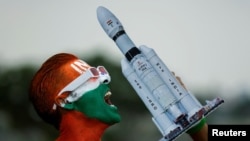Indian scientists are aiming to put a lander on the moon Wednesday, hoping that the country will become the first to touch down on the lunar surface’s south pole.
India’s attempt will be made days after Russia’s Luna-25 lander, also headed for the unexplored south pole, crashed into the moon.
The Indian Space Research Organization (ISRO) expressed optimism about its moon mission on Tuesday. “The mission is on schedule. Systems are undergoing regular checks. Smooth sailing is continuing. The Mission Operations Complex (MOX) is buzzed with energy & excitement!,” it said on X.
It is India’s second attempt to reach the south pole -- four years ago, India’s lander crashed during its final approach.
If the mission is successful, India would become the fourth country to achieve what is called a “soft-landing” on the moon – a feat accomplished by the United States, China and the former Soviet Union.
However, none of those lunar missions landed at the south pole. “If you look at the spacecrafts that went to the moon in the 1960s and 1970s, they all landed in latitudes somewhere around the equator or the center of the moon as we view it from the earth, because those are relatively easy to access,” explained Chaitanya Giri, Associate Professor, Environmental Sciences at Flame University, Pune.
The south side, where the terrain is rough and rugged, has never been explored.
The current mission, called Chandrayaan-3, that blasted into space on July 14 follows the earlier one that could not put a lander on the moon. Chandrayaan means moon vehicle in Sanskrit and Hindi.
Space experts say scientists have taken into account the factors that led to the failed landing in 2019.
“It’s a complex maneuver. As far as possible ISRO has made changes and taken care to ensure that the descent to the moon’s surface happens safely and in an expected manner,” said Giri. “The rest, of course, depends on any technical glitch that may arise.”
The space agency has released Images of the far side of the moon -- it said it has been mapping the area to locate what it called “a safe landing area -- without boulders or deep trenches."
“All systems are working perfectly and no contingencies are anticipated,” ISRO Chairman S. Somnath said on Monday, according to a government statement.
If the mission goes according to plan, a rover being carried by the lander will stay on the moon for two weeks examining the lunar surface for the presence of water, minerals and studying its topography. Scientists believe the polar craters may contain water which would be critical to support human settlements on the moon that may be planned in the future.
This is India’s third mission to the moon and is part of its ambitions to be counted among a major space faring nation. The first one in 2008 that involved orbiting the moon helped confirm evidence of water on the lunar body.
Anticipation is growing about the mission in the country, especially after Russia’s mission failed after encountering problems as it moved into its pre-landing orbit.
Jitendra Singh, science and technology minister, expressed hope that “it will script a new history of planetary exploration.”
The landing is scheduled for 6:04 pm Indian time on Wednesday and will be livestreamed on ISRO’s website, its YouTube channel and by India’s public broadcaster.








